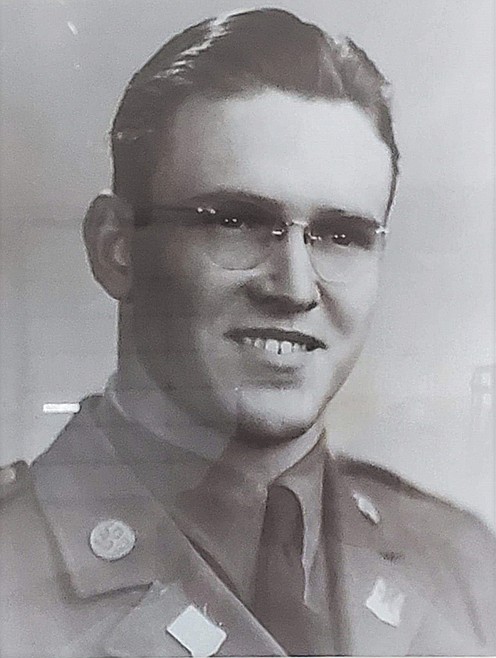When making annual preparations for the approaching Memorial Day, Tim Theroff, general manager of Riverview Cemetery in Jefferson City, was strolling through the cemetery grounds when he observed a grave with military markings that had not been decorated with a small U.S. flag.
"The headstone showed that the veteran had been killed in action, but since he did not have a traditional VA marker, it had been inadvertently overlooked by the volunteers who place flags on the graves," Theroff said.
Contacting the Silver Star Families of America for additional information on the veteran buried there, Theroff discovered it was a soldier who possessed a fascinating story of military service spanning the National Guard and U.S. Army in addition to connecting the Missouri communities of Jefferson City, Windsor and Clinton.
Born March 23, 1918, in Jefferson City, Leonard O. Taggart was raised in a family of six siblings. Sadly, a 2-year-old brother died in 1927, followed by his mother, Dena, who died in 1936; both were buried in Riverview Cemetery.
The young Taggart went on to attend local schools before moving with his family to the small city of Windsor, where he was employed by the International Shoe Company.
The June 9, 1959, edition of the Clinton Eye (Clinton, Missouri) reported Taggart became a member of "Battery E, 128th Field Artillery Regiment and (was) with the Clinton National Guard unit when it was inducted into federal service on November 25, 1940."
The unit was later redesignated Battery B, 231st Armored Field Artillery (AFA) Battalion and "trained at Ft. Jackson (South Carolina), Camp Blanding (Florida), Camp Chaffee (Arkansas), the Mojave Desert, California and at Camp Cook (California)," the newspaper further noted.
Operating as an organic unit under the 6th Armored Division, the 231st AFA participated in several major campaigns of the war in Europe following their arrival overseas in 1943, which included locations in England, France, Luxembourg, Belgium and Germany.
The Windsor Review (Windsor, Missouri) reported on March 30, 1944, that Taggart and his brother were serving overseas. They wrote, "Cpl. Kenneth Taggart and Cpl. Leonard Taggart are now in England, not together but where they will be able to see each other occasionally "
Taggart was with the 231st AFA when the 6th Armored Division entered France through Utah Beach in July 1944, the month following the initial D-Day landings. Their impressive legacy of combat included the Battle for Brest in addition to the Battle of the Bulge, the latter of which Taggart would not experience.
On Aug. 3, 1944, the Windsor Review wrote, "Tuesday's Kansas City Times gave a long list of Missourians that were recently in action against the Germans in France, most of them were from old National Guard units. Listed from Windsor were Sgt. Bates Griffith and Pvt. Leonard Taggart."
However, it was the battery's efforts to help establish a bridgehead that would lead to the memorialization of Taggart's name. During operations at Han-sur-Nied, France on Nov. 11, 1944, the halftrack Taggart was operating was hit with an enemy round, severely wounding the 26-year-old soldier from Missouri.
"George Taggart received a message Sunday from the War Department saying his son, Cpl. Leonard Taggart, had been seriously wounded in action on November 11 in France," reported the Dec. 7, 1944, edition of the Henry County Democrat (Clinton, Missouri).
The newspaper added, "Wednesday morning Mr. Taggart received a second message from the Adjutant General's office stating his son died November 12 in France as a result of wounds received in action on November 11."
The paper also reported the death of Taggart represented the ninth Gold Star (military death) of the war for Windsor, which, according to the 1940 census, was a community of only 2,373, residents.
The remains of the veteran were initially laid to rest in a military cemetery in Lorraine, France.
"George L. Taggart has been notified that the body of his son arrived in New York from Europe aboard the United States Army Transport Oglethorpe Victory," the Windsor Review reported July 22, 1948. "The final destination requested by his father is Jefferson City, Missouri, the former home of the Taggart family."
Taggart's return was part of a program in operation from 1947 until the 1960s, which afforded certain next of kin of those killed in World War II to have the remains of their loved ones repatriated to the United States at the expense of the government for burial in a local cemetery or national cemetery.
Funeral services for Taggart were held in Jefferson City on Aug. 22, 1948, with members of the Windsor American Legion post participating. The veteran was then laid to rest in a grave alongside his mother in Riverview Cemetery.
A second memorialization for the fallen WWII soldier came June 7, 1959, with the naming of a new National Guard armory. It was on this date the French-Taggart Memorial Armory was co-named in honor of Taggart and the late Alva A. French, also a member of the former Battery E, 128th Field Artillery who was killed in action.
Tim Theroff, of Riverview Cemetery, is hopeful a traditional-style military marker can someday be obtained for Taggart's grave to make it more discernible as a veteran's gravesite. Although his headstone is eligible for a small veteran's medallion, the Department of Veterans Affairs does not provide markers for graves of this era in cemeteries where the veteran already has a private headstone.
"He is truly a hero and deserves to be recognized for his service with a flag on Memorial Day," Theroff said. "His headstone is easily overlooked, and someday I won't be here to ensure this is done. I want to make sure that those who come after me can continue to honor his memory, just as he deserves."
Jeremy P. Amick writes on behalf of the Silver Star Families of America.

